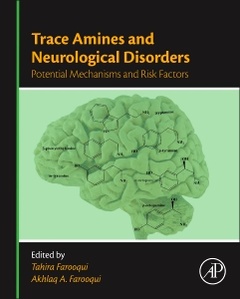Trace Amines and Neurological Disorders Potential Mechanisms and Risk Factors
Coordonnateurs : Farooqui Tahira, Farooqui Akhlaq A.

Trace Amines and Neurological Disorders: Potential Mechanisms and Risk Factors explores trace amines which, under normal conditions, are present in the mammalian brain and peripheral nervous tissues at very low (nanomolar) concentrations. However, in a diverse array of human pathologies ranging from substance abuse, depression, attention deficit hyperactivity disorder, eating disorders, schizophrenia, and other neurological and neuropsychiatric diseases, the levels of trace amines are unusually high with an imbalance in their functions. Furthermore, the rapid turnover of trace amines is evidenced by their dramatic increases following treatment with monoamine oxidase inhibitors (MAOI) or deletion of the MAO genes. This suggests that the concentration of trace amines may be considerably higher at neuronal synapses than predicted by steady-state measures, implicating some pathophysiological role. Therefore, understanding molecular mechanisms and developing selective agonists and antagonists for trace amine-associated receptors (TAARs) has become a good approach for treating these diseases. Although the effects of trace amines at low physiological concentrations in mammalian species have been difficult to demonstrate, they may serve to maintain the neuronal activity of other monoamine neurotransmitters by possessing postsynaptic modulatory effects, particularly dopamine and serotonin, within defined physiological limits. Such an effect of trace amines makes them ideal candidates for the development of novel therapeutics for a wide range of human disorders. This book presents up-to-date, cutting-edge, and comprehensive information on the link between trace amines and neurological disorders.
Section I. Introduction and Description of Trace Amines and Trace Amine-Associated Receptors 1. Trace Amines: An Overview 2. Methods of Trace Amines Analysis in Mammalian Brain 3. Synthesis and Neurochemistry of Trace Amines 4. The Origin and Evolution of the Trace Amine-Associated Receptor Family in Vertebrates 5. Differential Modulation of Adrenergic Receptor Signaling by Octopamine, Tyramine, Phenylethylamine, and 3-Iodothyronamine 6. Effects of Trace Amines on the Dopaminergic Mesencephalic System 7. Trace Amine-Associated Receptors in the Cellular Immune System 8. Trace Amines and Their Receptors in the Control of Cellular Homeostasis 9. Trace Amine-Associated Receptor 1 Modulation of Dopamine System 10. Trace Amines as Intrinsic Monoaminergic Modulators of Spinal Cord Functional Systems 11. Trace Amine-Associated Receptors: Ligands and Putative Role in the Central Nervous System 12. B-Phenylethylamine Requires the Dopamine Transporter to Release Dopamine in Caenorhabditis elegans
Section II. Trace Amines and Olfaction 13. Trace Amines-Mediated Olfactory Learning and Memory in Mammals and Insects: A Brief Comparative Review 14. Octopaminergic and Tyraminergic Signaling in the Honeybee (Apis mellifera) Brain: Behavioral, Pharmacological, and Molecular Aspects 15. Octopamine and Tyramine Signaling in Locusts: Relevance to Olfactory Decision-Making
Section III. Trace Amines and Neurological Disorders 16. Neurochemical Aspects of Neurological Disorders 17. Trace Amines and Their Relevance to Neurological Disorders: A Commentary 18. Trace Amines in Neuropsychiatric Disorders 19. B-Phenylethylamine-Class Trace Amines in Neuropsychiatric Disorders: A Brief Historical Perspective 20. Involvement of So-Called D-Neuron (Trace Amine Neuron) in the Pathogenesis of Schizophrenia: D-Cell Hypothesis 21. 3-Iodothyronamine, a New Chapter in Thyroid Story: Implications in Learning Processes 22. Trace Amine Receptors and Mood Disorders 23. Trace Amine Associated Receptor 1: Implications for Treating Stimulant Drug Addiction 24. Trace Amines and Their Potential Role in Primary Headaches
Section IV. Perspective 25. Perspective and Directions for Future Research on Trace Amines and Neurological Disorders
Practitioners and researchers in the fields of neuroscience, neurology, neuropharmacology, and neurochemistry
Akhlaq A. Farooqui is a leader in the field of signal transduction processes, lipid mediators, phospholipases, glutamate neurotoxicity, and neurological disorders. He is a research scientist in the Department of Molecular and Cellular Biochemistry at The Ohio State University. He has published cutting edge research on the role of phospholipases A2 in signal transduction processes, generation and identificat
- Focuses on recent findings on trace amines, providing insights into the functional significance, molecular mechanisms, and biological relevance of TAARS in neurological disorders
- Edited work with chapters authored by leaders in the field from around the globe, the broadest, most expert coverage available
- Provides cutting-edge research on trace amines-mediated signaling in vertebrate model systems
Date de parution : 08-2016
Ouvrage de 432 p.
19x23.3 cm



